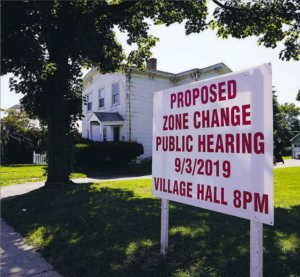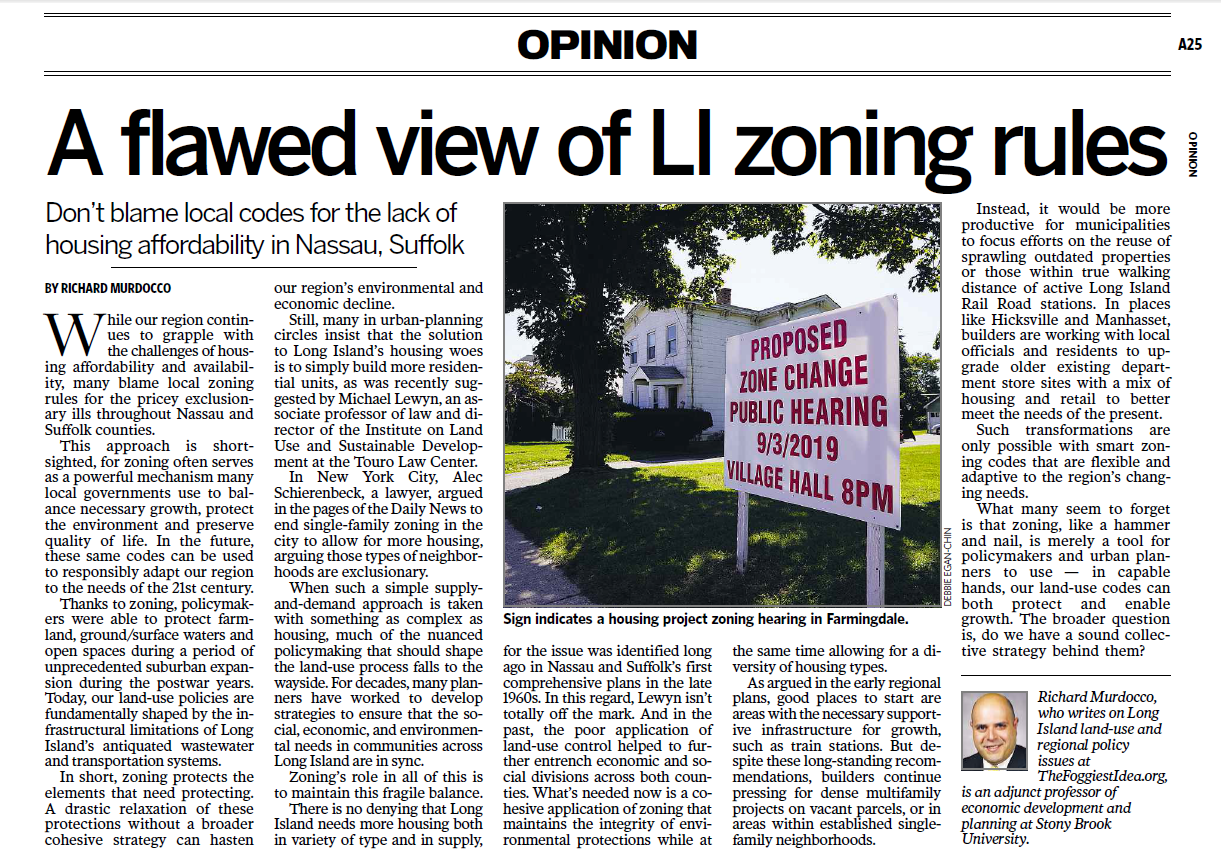The following op-ed was first published in the December 6th, 2019 edition of Newsday on page A25. You can read the original here.
Don’t blame local codes for the lack of housing affordability in Nassau, Suffolk
By Richard Murdocco
While our region continues to grapple with the challenges of housing affordability and availability, many blame local zoning rules for the pricey exclusionary ills throughout Nassau and Suffolk counties.
This approach is shortsighted, for zoning often serves as a powerful mechanism many local governments use to balance necessary growth, protect the environment and preserve quality of life. In the future, these same codes can be used to responsibly adapt our region to the needs of the 21st century.

A sign indicating a housing project zoning hearing in Farmingdale. (Photo Credit: Newsday’s Debbie Egan-Chin)
Thanks to zoning, policymakers were able to protect farmland, ground/surface waters and open spaces during a period of unprecedented suburban expansion during the postwar years. Today, our land-use policies are fundamentally shaped by the infrastructural limitations of Long Island’s antiquated wastewater and transportation systems.
In short, zoning protects the elements that need protecting. A drastic relaxation of these protections without a broader cohesive strategy can hasten our region’s environmental and economic decline.
Still, many in urban-planning circles insist that the solution to Long Island’s housing woes is to simply build more residential units, as was recently suggested by Michael Lewyn, an associate professor of law and director of the Institute on Land Use and Sustainable Development at the Touro Law Center.
Further west in New York City, Alec Schierenbeck, a lawyer, argued in the pages of the New York Daily News to end single-family zoning in the city to allow for more housing, arguing those types of neighborhoods are exclusionary.
When such a simple supply-and-demand approach is taken with something as complex as housing, much of the nuanced policymaking that should shape the land-use process falls to the wayside. For decades, many planners have worked to develop strategies to ensure that the social, economic, and environmental needs in communities across Long Island are in sync.
Zoning’s role in all of this is to maintain this fragile balance.
There is no denying that Long Island needs more housing both in variety of type and in supply, for the issue was identified long ago in Nassau and Suffolk’s first comprehensive plans in the late 1960s. In this regard, Lewyn isn’t totally off the mark. And in the past, the poor application of land-use control helped to further entrench economic and social divisions across both counties. What’s needed now is a cohesive application of zoning that maintains the integrity of environmental protections while at the same time allowing for a diversity of housing types.
As argued in these early regional plans, a good place to start are areas with the necessary supportive infrastructure for growth, such as train stations. But despite these longstanding recommendations, builders continue pressing for dense multifamily projects on vacant parcels, or in areas within established single-family neighborhoods.
Instead, it would be more productive for municipalities to focus efforts on the reuse of sprawling outdated properties or those within true walking distance of active Long Island Rail Road stations. In places like Hicksville and Manhasset, builders are working with local officials and residents to upgrade older existing department store sites with a mix of housing and retail to better meet the needs of the present.
Such transformations are only possible with smart zoning codes that are both flexible and adaptive to the region’s changing needs.
What many seem to forget is that zoning, like a hammer and nail, is merely a tool for policymakers and urban planners to use — in capable hands, our land-use codes can both protect and enable growth. The broader question is, do we have a sound collective strategy behind them?
Richard Murdocco, who writes on Long Island land-use and regional policy issues at TheFoggiestIdea.org, is an adjunct professor of economic development and planning at Stony Brook University.













